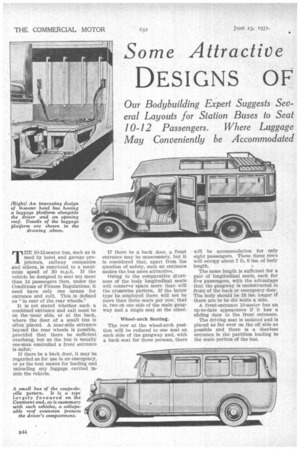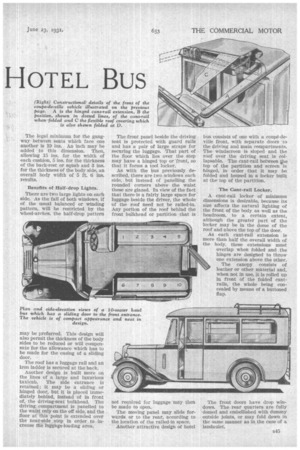Some Attractive
Page 58

Page 59

If you've noticed an error in this article please click here to report it so we can fix it.
DESIGNS OF
HOTEL Bus
Our Bodybuilding Expert Suggests Several Layouts for Station Buses to Seat 1 0I 2 Passengers. Where Luggage May Conveniently be Accommodated
TEE 10-12-seater bus,. such as is used by hotel anti garage proprietors, railway companies and others, is restricted to a maximum speed of 30 m.p.h. If the vehicle be designed to seat not more than 14 passengers then, under the Conditions of Fitness Regulations,' it need have only one means for entrance and exit. This is defined as "in rear of the rear wheels."
It is not stated whether such a combined entrance and exit must be on the tnear side, or at the back, where the door of a small bus is often placed. A near-side entrance beyond the rear wheels is possible, provided that there be sufficient overhang, but as the bus is "risually one-than controlled a front entrance is safer: If there be a back door, it may be regarded as for use in an emergency, or as the best means for loading and unloading any luggage carried inside the vehicle.
If there be a back door, a front entrance may be unnecessary, but it is considered that, apart from the question of safety, such an entrance makes the bus more attractive.
Owing to the cotnparative shortness of the body longitudinal seats will conserve space more than will the crosswise pattern. If the latter type be employed there will not be more than three seats per row, that is, two on one side of the main gangway and a single seat on the other.
Wheel-arch Seating.
The row at the wheel-arch position will be reduced to one seat on each side of the gangway and, with a back seat for three persons, there will be accommodal ion for only eight passengers. These three tows will occupy about 7 ft. 6 ins, of body length.
The same length is sufficient for a pair of longitudinal seats, each for five passengers, with the advantage that the gangway is unobstructed in front of the back or emergency door. The body should be 18 ins, longer if there are to be six seats a side.
A front-entrance 10-seater has an up-to-date appearance if it has a sliding door to the front entrance.
The driving seat is isolated and is placed as far over on the off side as possible and there is a doorless entrance in the partition leading to the main portion of the bus. The legal minimum for the gangway between seats which face one another is 19 ins.. An inch may be added to this dimension. Then, allowing 15 ins. for the width of each cushion, 5 ins, for the thickness of the back-rest or squab and 3 ins. for the thickness of the body side, an overall body width of 5 ft. 6 ins. results.
Benefits of Hall-drop Lights.
There are two large lights on each side. As the fall of both windows, if of the usual balanced or winding pattern, will he restricted by the wheel-arches, the half-drop pattern
may be preferred. This design will also permit the thickness of the body sides to be reduced or will compensate for the allowance which has to be made for the casing of a sliding door.
The roof has a luggage rail and an iron ladder is secured at the back.
Another design is built more on the lines of a large and luxurious taxicab. The side entrance is retained ; it may be a sliding or hinged door, but it is placed immediately behind, instead of in front of, the driving-seat bulkhead. The driving compartment is panelled to the waist only on the off side, and the floor at this point is extended over the near-side step in order, to increase the luggage-loading area. The front panel beside the driving seat is protected with guard rails and has a pair of large straps for securing the luggage. That part of the floor which lies over the step may have a hinged top or-front, so that it forms a tool locker.
As with the bus previously described, there are two windows each side, but instead of panelling the rounded corners above the waist these are glazed. In view of the fact. that there is a fairly large space for luggage beside the driver, the whole of the roof need not be railed-in. Any portion' of the roof behind the front bulkhead or partition that is
not required for luggage may then be made to open.
The moving panel may slide forwards or to the rear, according to the location of the railed-in space.
Another attractive design of hotel bus consists of one with a coupe-dcyule front, with separate doors to the driving and main compartments. The windscreen iS sloped and the roof over the driving seat is collapsable. The cant-rail between 1,he top of the partition and screen is binged, in order that it may be folded and housed in a locker built at the top of the partition.
The Cant-rail Locker.
A cant-rail locker of minimum dimensions is desirable, because its size affects the natural lighting of the front of the body as well as the headroom, to a certain extent, although the greater part of the locker may be in the dome of the roof and above the top of the door.
As each cant-rail extension is more than half the overall width of the body, these extensions must overlap when folded and the hinges are designed to throw one extension above the other.
The canopy consists of leather or other material and, when not in use, it is rolled up in front of the foldedcantrails, the whole being concealed by means of a buttoned flap.
The front doors have drop windows. The rear quarters are fully domed and embellished with dummy outside joints, or may fold down in the same manner as in the case of a landaulet.




























































































